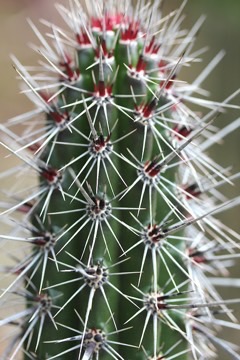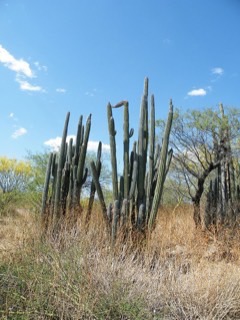 |
|
Peter A. Mansfeld wikimedia.org |
 |
| Amante Darmanin wikimedia.org |
Translate this page:
Summary
The genus Pachycereus contains some of the largest growing cacti with species reaching 25m (82ft) in height. Pachycereus hollianus commonly know as Baboso is a shrubby or arborescent, clustering, plant 3 to 5 m high. All Pachycereus species are columnar and feature tree-like or shrubby growth with relatively large branches. It is endemic to the Mexican states of Oaxaca and Puebla. This name, Pachycereus hollianus, is unresolved, but some data suggest that it is synonymous with Lemaireocereus hollianus (F.A.C. Weber) Britton & Rose.
Physical Characteristics

 Pachycereus hollianus is an evergreen Perennial growing to 4 m (13ft) by 1 m (3ft 3in) at a medium rate.
Pachycereus hollianus is an evergreen Perennial growing to 4 m (13ft) by 1 m (3ft 3in) at a medium rate.
See above for USDA hardiness. It is hardy to UK zone 10.
Suitable for: light (sandy) and medium (loamy) soils, prefers well-drained soil and can grow in nutritionally poor soil. Suitable pH: mildly acid, neutral and basic (mildly alkaline) soils. It cannot grow in the shade. It prefers dry or moist soil and can tolerate drought.
UK Hardiness Map
US Hardiness Map
Synonyms
This name is unresolved, but some data suggest that it is synonymous with Lemaireocereus hollianus (F.A.C. Weber) Britton & Rose .
Plant Habitats
Edible Uses
None Known. Some species in this genus have edible fruit or seeds but no reference come be found for Pachycereus hollianus
References More on Edible Uses
Medicinal Uses
Plants For A Future can not take any responsibility for any adverse effects from the use of plants. Always seek advice from a professional before using a plant medicinally.
None Known
References More on Medicinal Uses
The Bookshop: Edible Plant Books
Our Latest books on Perennial Plants For Food Forests and Permaculture Gardens in paperback or digital formats.

Edible Tropical Plants
Food Forest Plants for Hotter Conditions: 250+ Plants For Tropical Food Forests & Permaculture Gardens.
More

Edible Temperate Plants
Plants for Your Food Forest: 500 Plants for Temperate Food Forests & Permaculture Gardens.
More

More Books
PFAF have eight books available in paperback and digital formats. Browse the shop for more information.
Shop Now
Other Uses
Carbon Farming Solutions - Agroforestry Services: living fence (Agroforestry is a land use management system in which trees or shrubs are grown around or among crops or pastureland). Gardening: Fence, Landscaping, Ornamental. Drought-tolerant; suitable for xeriscaping
Special Uses
Carbon Farming
References More on Other Uses
Cultivation details
Agroforestry Services: Living fence Regional Crop
Climate: subtropical to tropical. Humidity: arid to semi-arid. Grows in dry deciduous forests and arid scrubland, at elevations between 1500 and 1800m (4900 and 5900ft.). It is tolerated in agricultural lands and used as living fences. It thrives in hot, dry climates and may tolerate mild frost once established. Water Requirements: Low. Drought Tolerant. Soil pH requirements: 6.1 (mildly acidic) to 7.8 (mildly alkaline). Carbon Farming Solutions - Cultivation: regional crop (Describes the non-destructive management systems that are used in cultivation) [1-1].
Carbon Farming
-
Agroforestry Services: Living fence
Simply managed rows of shrubs and trees.
-
Regional Crop
These crops have been domesticated and cultivated regionally but have not been adopted elsewhere and are typically not traded globally, Examples in this broad category include perennial cottons and many nuts and staple fruits.
References Carbon Farming Information and Carbon Sequestration Information
Temperature Converter
Type a value in the Celsius field to convert the value to Fahrenheit:
Fahrenheit:
The PFAF Bookshop
Plants For A Future have a number of books available in paperback and digital form. Book titles include Edible Plants, Edible Perennials, Edible Trees,Edible Shrubs, Woodland Gardening, and Temperate Food Forest Plants. Our new book is Food Forest Plants For Hotter Conditions (Tropical and Sub-Tropical).
Shop Now
Plant Propagation
Seed sown directly and stem cuttings. Allow cut surface to callous over before planting. Plant is viviparous (reproducing from buds which form plantlets while still attached to the parent plant,).
Other Names
If available other names are mentioned here
Baboso, Acompes
Native Range
Coming Soon
Weed Potential
Right plant wrong place. We are currently updating this section.
Please note that a plant may be invasive in one area but may not in your area so it's worth checking.
None Know. It can be an aggressive colonizer and tolerates disturbance but is tolerated by people.
Conservation Status
IUCN Red List of Threatened Plants Status : Status: Least Concern

Growth: S = slow M = medium F = fast. Soil: L = light (sandy) M = medium H = heavy (clay). pH: A = acid N = neutral B = basic (alkaline). Shade: F = full shade S = semi-shade N = no shade. Moisture: D = dry M = Moist We = wet Wa = water.
Now available:
Food Forest Plants for Mediterranean Conditions
350+ Perennial Plants For Mediterranean and Drier Food Forests and Permaculture Gardens.
[Paperback and eBook]
This is the third in Plants For A Future's series of plant guides for food forests tailored to
specific climate zones. Following volumes on temperate and tropical ecosystems, this book focuses
on species suited to Mediterranean conditions—regions with hot, dry summers and cool, wet winters,
often facing the added challenge of climate change.
Read More
Expert comment
Author
(F.A.C.Weber in J.M.Coult.) Buxb.
Botanical References
Links / References
For a list of references used on this page please go here
Readers comment
| Add a comment |
|
If you have important information about this plant that may help other users please add a comment or link below. Only comments or links that are felt to be directly relevant to a plant will be included. If you think a comment/link or information contained on this page is inaccurate or misleading we would welcome your feedback at [email protected]. If you have questions about a plant please use the Forum on this website as we do not have the resources to answer questions ourselves.
* Please note: the comments by website users are not necessarily those held by PFAF and may give misleading or inaccurate information.
To leave a comment please Register or login here All comments need to be approved so will not appear immediately.
|
Subject : Pachycereus hollianus
|
|
|
|